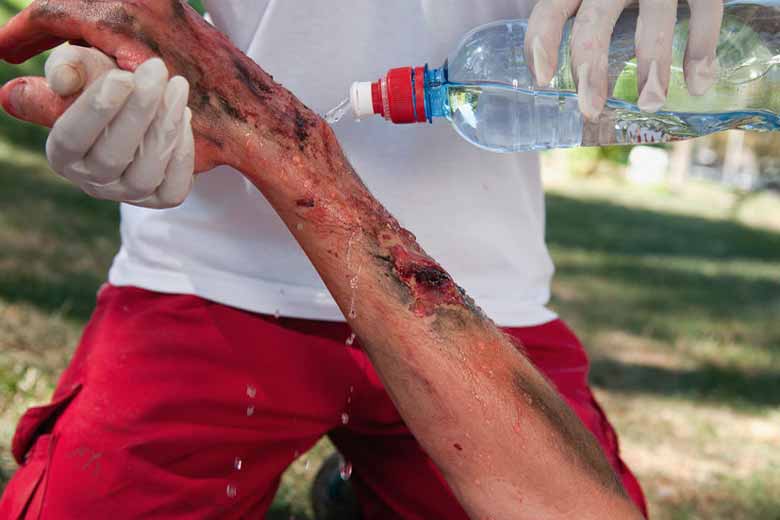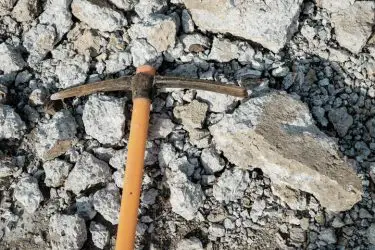When working in construction, there are always safety risks. While the risks are unavoidable, it is wise to do everything possible to minimize them, including the safe and proper use of concrete.
Concrete can burn your skin. If you accidentally expose your skin or clothes to concrete, it can cause painful burns that get worse over time, potentially causing second or third-degree burns. But concrete burns are avoidable with the proper use of protective equipment and following the instructions.
If you are planning on working with concrete anytime soon, you should be aware of the risks associated with concrete, as well as signs and symptoms of a concrete burn, treatment, and prevention. Continue reading for all the facts on concrete burns.

Table of Contents
Why Does Concrete Burn Your Skin?
Cement is composed mainly of calcium oxide, which, when mixed with water, produces calcium hydroxide. This chemical has an extremely high pH level (pH of 12 on a scale of 0 to 14), meaning it has more alkaline than acidity.
The high pH level means that wet concrete and even dry cement powder can result in severe burns to your skin.
Signs and Symptoms
If you get concrete on your skin, you may not notice right away that it hurts or that your skin is reacting.
The concrete is sneaky, and the burns develop for several hours, so keep an eye out on the affected area. This section will go over a few symptoms you might experience if you accidentally expose your skin or clothes to wet concrete.
Shortly after the initial contact between concrete and your skin, the affected area will be slightly red or pink and skin dryness. However, this is just the beginning, and the symptoms are likely to worsen over time.
It will continue to get red and feel irritated, and eventually begin to be painful.
If the concrete is left untreated and dries on the skin, you will likely develop severe blisters and scabs. The burns could transform into third-degree burns, requiring immediate medical attention.
Risks of Working With Cement Long Term
Individuals who frequently work with cement have a higher chance of inhaling the dust produced by cement, mainly when bags are left out and during sanding and grinding concrete surfaces.
Short term, you may realize that it is difficult to breathe and causes a little bit of irritation in the throat and mouth.
Repeated exposure can lead to a dangerous lung disease called silicosis, which can even be fatal. Inhalation is avoidable by the use of proper masks.
Read more: Can Concrete Poisoning Kill You?
What if I Come Into Contact With Cement?
Accidents happen. If you or someone you know gets injured with a concrete burn, it will need to be treated as soon as possible. Read on to learn about the best way to handle a concrete burn.
Wash the Area With Water
As soon as your skin comes into contact with concrete, you should remove all clothes and protective equipment and wash the affected area with cool, running water for at least twenty minutes.
However, before running water on your skin, ensure that there is no dry cement powder on your skin, as mixing it with water creates a higher alkaline chemical.
Flashback to 6th-grade science class: the high pH level of concrete means that it can be neutralized with a more acidic solution.
OSHA recommends adding vinegar or some other acidic liquid to the water to combat the alkaline burn.
Call Poison Control
A concrete burn gets increasingly worse over several hours, making it a little bit unpredictable.
This characteristic also results in some burns getting more severe than necessary because the injured person is under the misconception that their burn is not that bad. If a concrete burn is left untreated, it can result in second or third-degree burns in a matter of hours.
If you or someone you know comes into contact with wet concrete, the best thing to do is call your local poison control agency.
They will offer the best guidance on the severity of the burns and the best next steps.
Medical Care and Antibiotics
More than likely, someone that has come into contact with wet concrete will have to go to the hospital. Even if they avoid it at first, the burn has likely worsened over time, resulting in a lot of pain.
The medical providers must be aware of the cause of the burn, as concrete burns are treated differently than other burns. They will potentially give you an antibiotic to fight off potential infections, depending on the burn’s severity.
How To Prevent Concrete Burns
Concrete burns are typically the result of an accident by well-intentioned people. While there are a few options for treatment, the ideal scenario is to prevent these accidents altogether. This section will detail several ways you can focus on preventing such an incident in your home or on your worksite.
Use Safety Gear
When working with potentially harmful substances, it is wise to use personal protective equipment to minimize accidents.
When working with wet concrete, you should wear waterproof boots at least as high as the concrete you will pour.
Your gloves should be resistant to alkaline and fit well to avoid concrete sneaking in at the wrists.
Your skin should also be covered entirely with long sleeves and pants, each tucked into your gloves and boots.
You should again wear a mask that will prevent the inhalation of cement dust.
Lastly, eyes are potentially the most vulnerable part of your body when it comes to concrete, so you should protect them with eye goggles that completely seal around your face.
Remove Clothing Carefully
Believe it or not, many concrete injuries occur not during the actual pouring process but when after the job is done.
When you remove your clothes after pouring concrete or mixing cement, it is essential to avoid getting any residue on your hands as you change.
Another safety tip is not storing your worksite clothes with everyday clothes, which can transfer harmful materials. You should also change your clothes immediately if you recognize that they have come in contact with concrete. It can cause injury when you take the clothes off or seep through the material onto your skin.
Follow Manufacturer’s Instructions
Due to cement and wet concrete’s caustic nature, following the manufacturer’s instructions is critical for safe use.
It is best not to assume you know how to properly mix and pour concrete before doing so. Even if you are confident, best practice says that you should read all instructions before proceeding.
Keep Dry Cement Out of Children’s Reach
If you are a parent, you know how exhausting it can be to chase a toddler around all day, keeping them from putting random objects in their mouth.
Ensuring that your children, especially the younger kids, can not access concrete is the best way to keep them safe.
The same rule applies to pets, as they may accidentally eat dry cement as well. They will experience the same painful symptoms as a human if consumed orally or if it comes in contact with their skin.
Final Thoughts
Working with concrete is inherently risky due to the caustic nature of cement. Whether you are a veteran concrete pourer or a first-timer, being informed on the science behind concrete and recognizing some of the common signs and symptoms can go a long way in preventing severe injuries for you and your work crew.
Furthermore, engaging with the most up to date safety practices and learning basic first-aid skills will best prepare you for handling an accident if one occurs.
Hopefully, you gleaned some helpful information from this article and will pour concrete safely in the future.
Also Read: Are Concrete Blocks Really Toxic?



